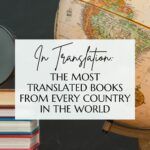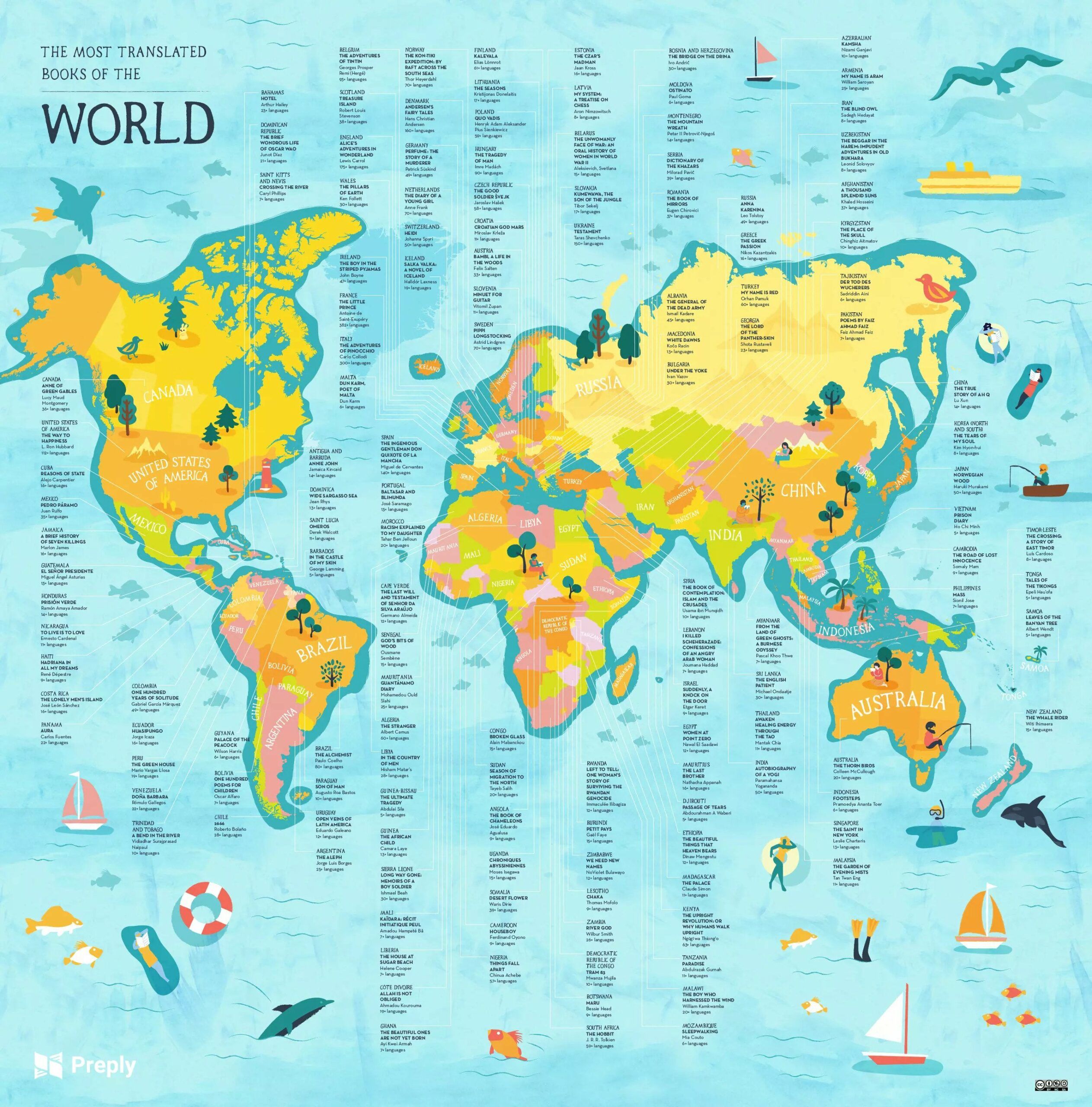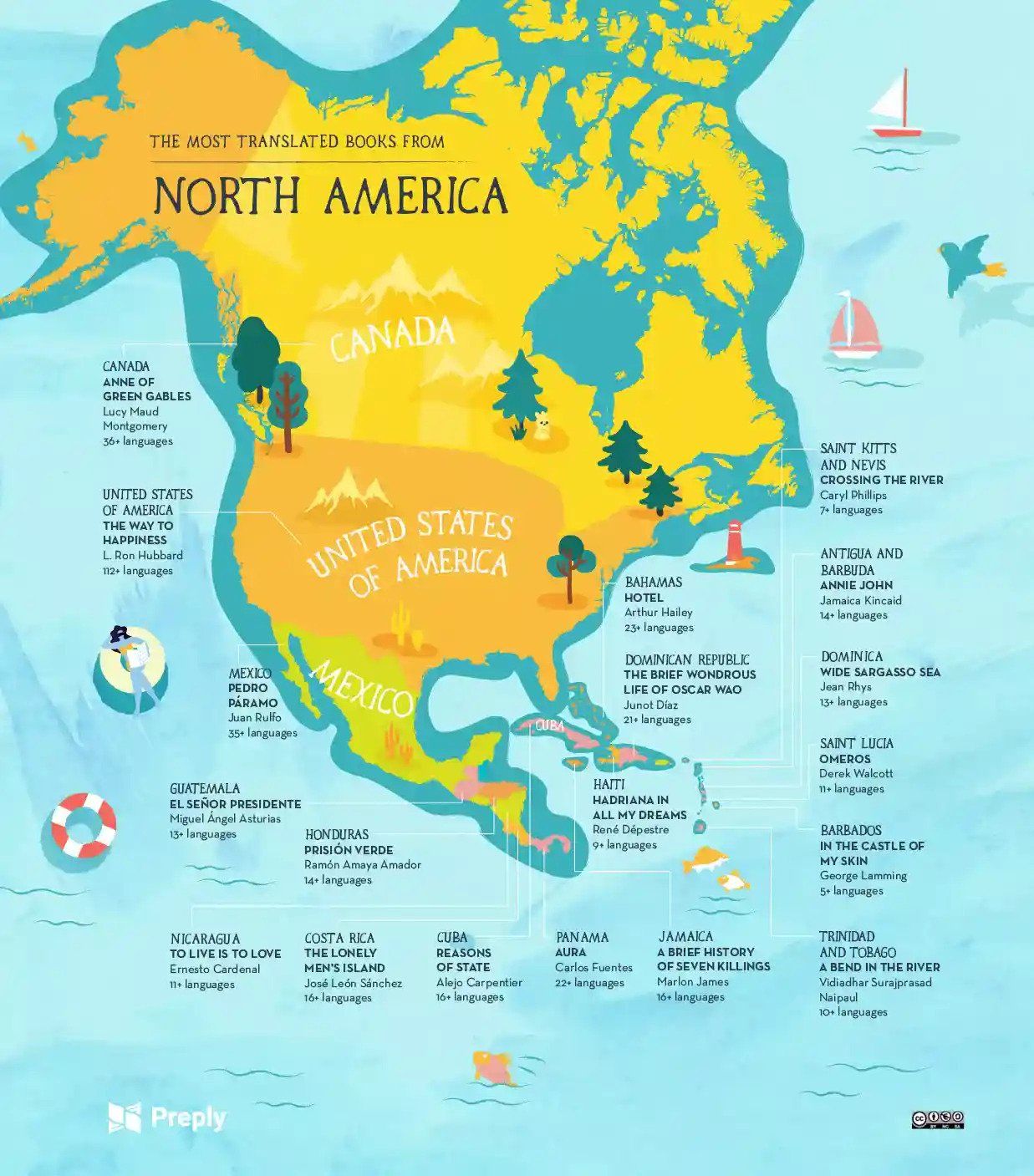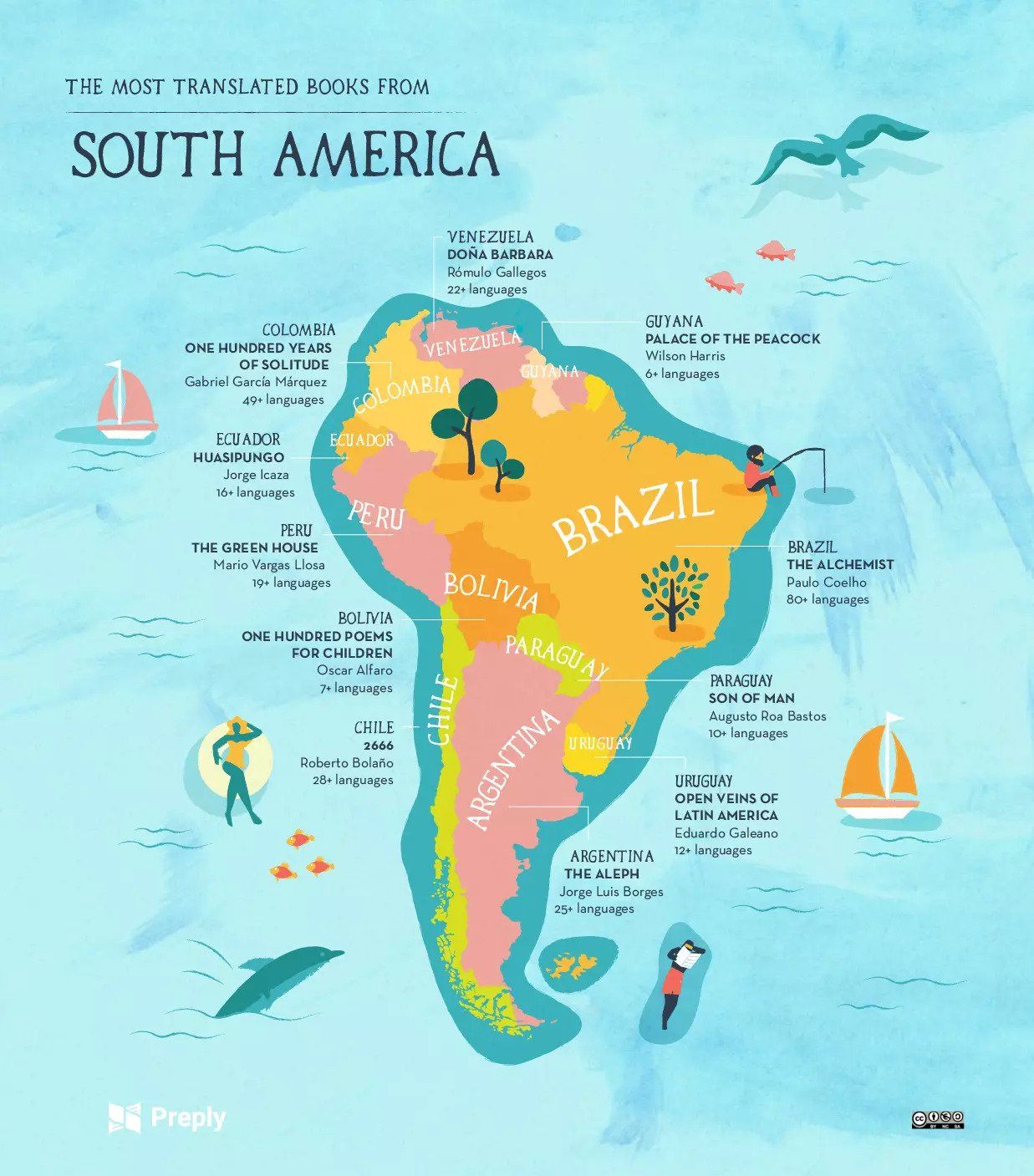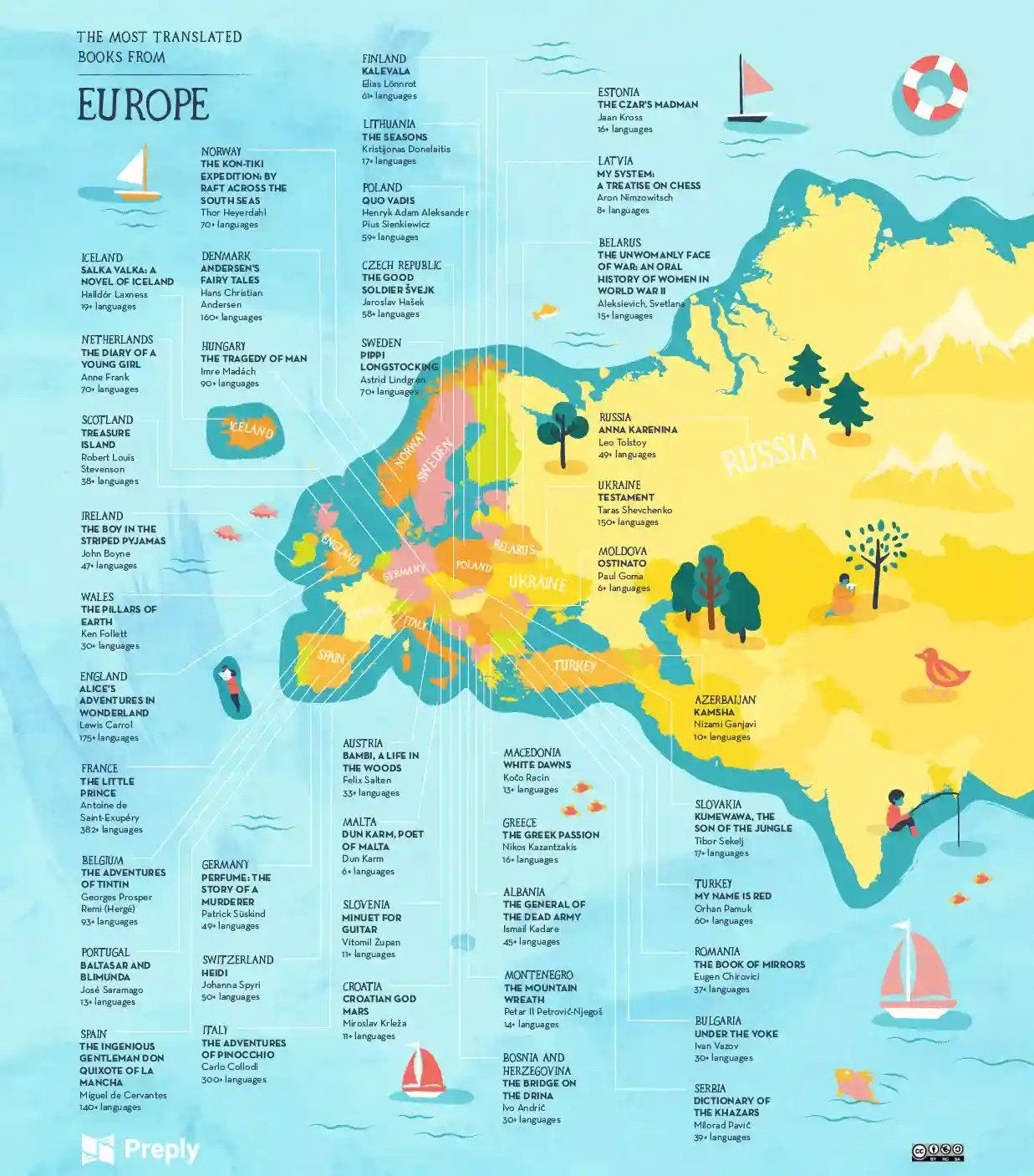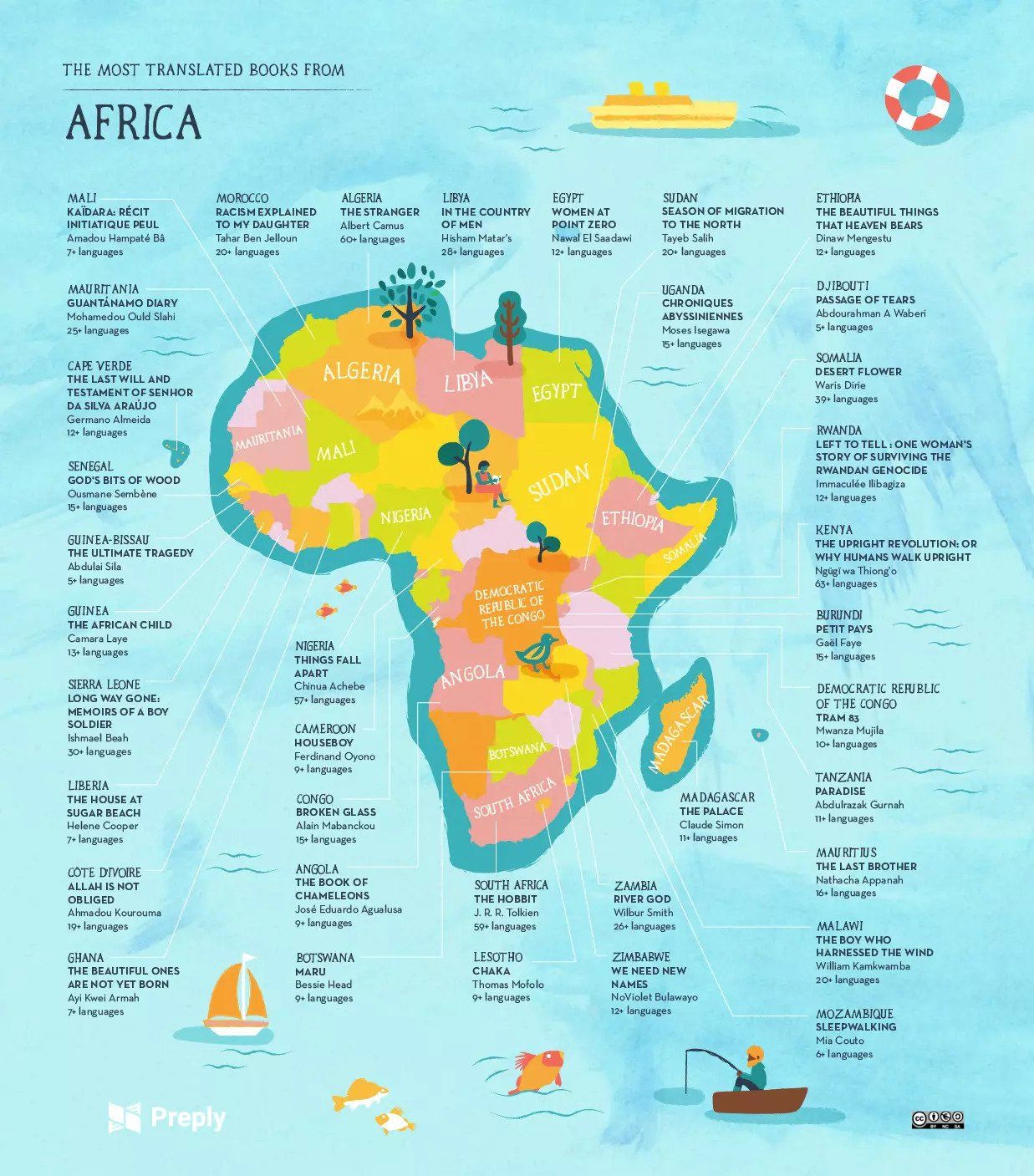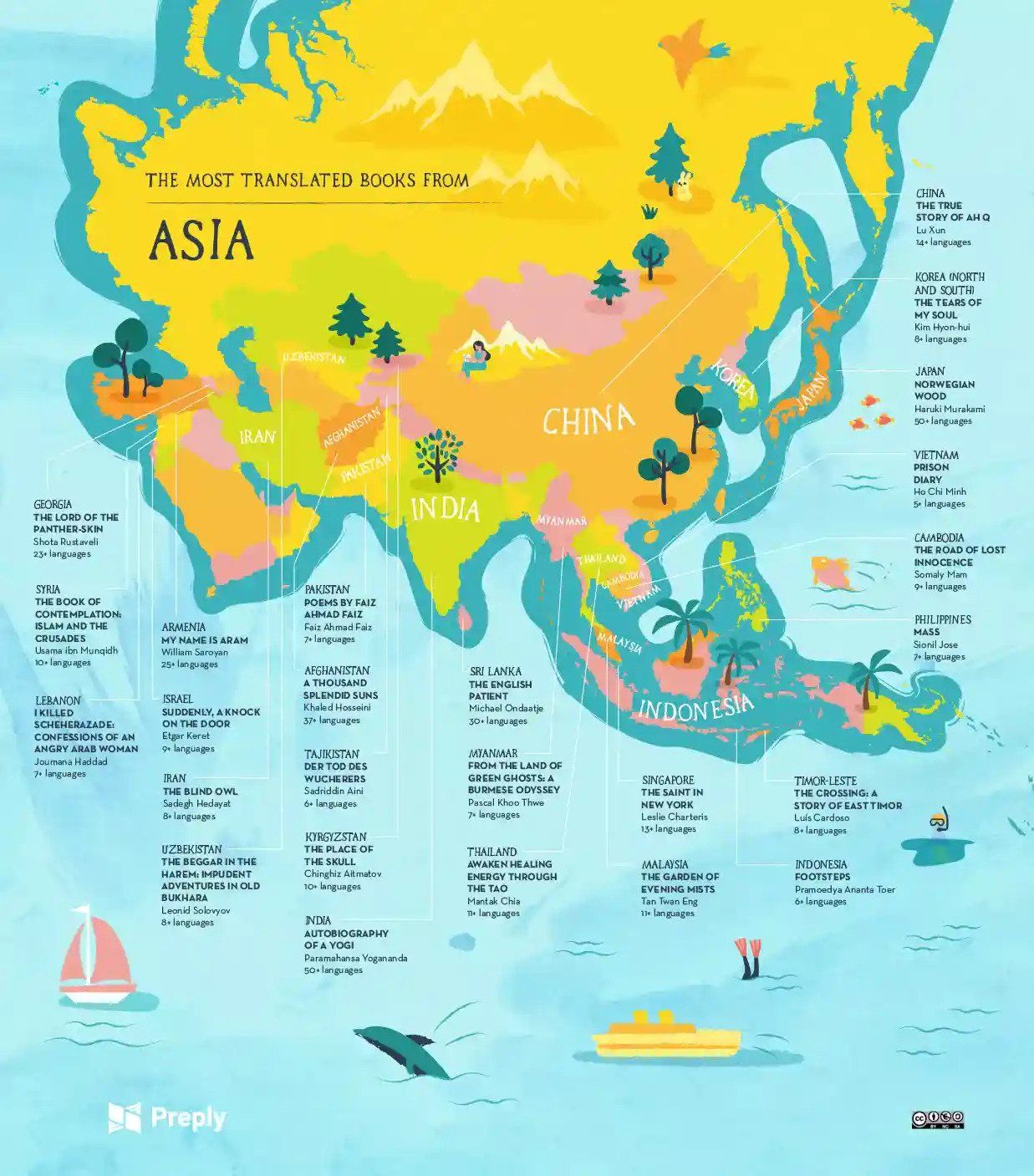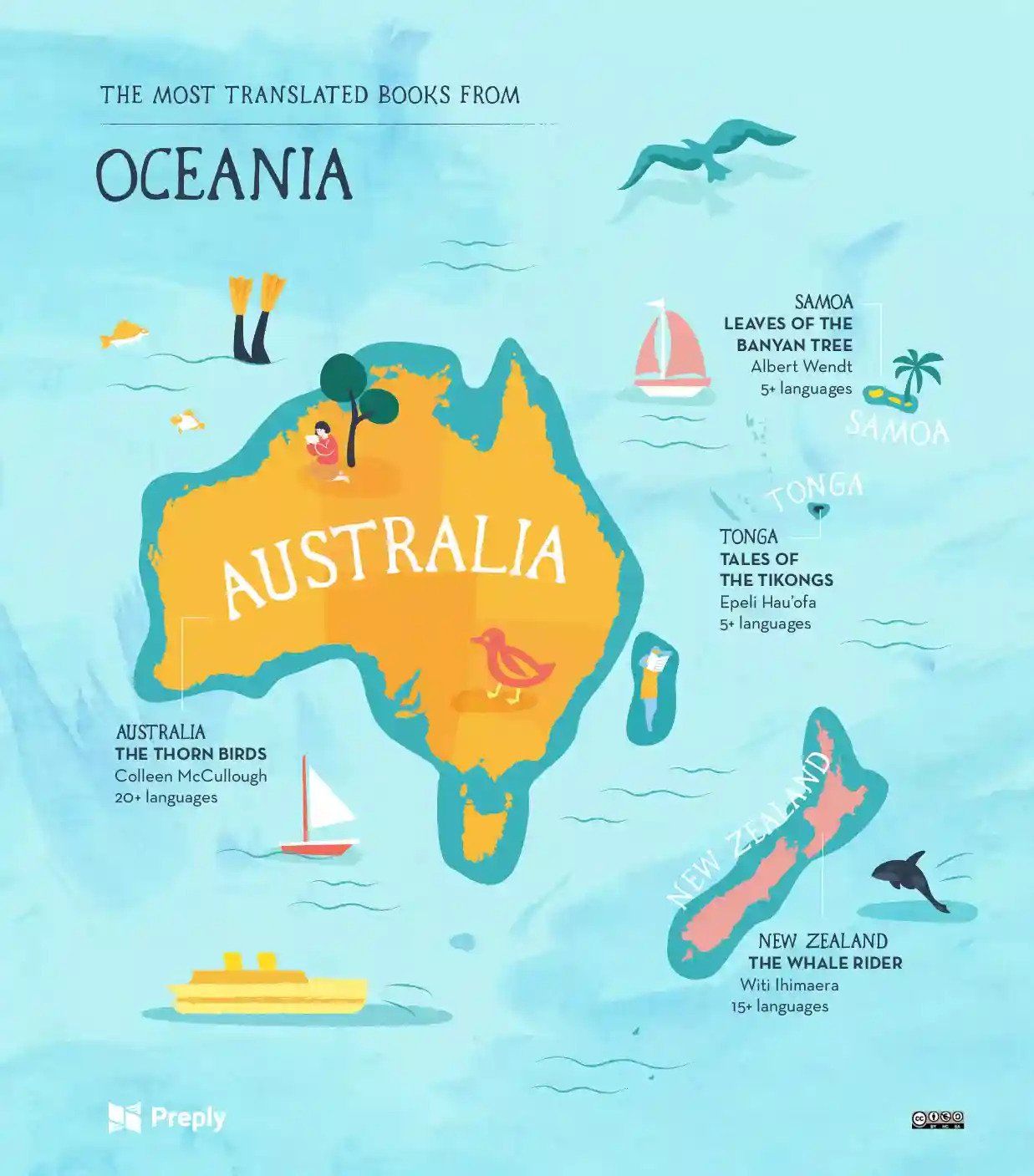If you’re looking for a place to start reading books in translation, Preply has created a great resource for you. They have compiled the most translated books by country, and presented the data in these beautiful maps! You can check out their original post for more information on some of the titles included.
The Most Translated Books of the World
Did you guess the most translated book in the world? It’s The Little Prince, which has been translated to more than 380 different languages! Following after that is The Adventures of Pinocchio by Carlo Collodi. These are both considered classics that have had many decades to accumulate translations. Preply excluded from these numbers religious texts that couldn’t be easily attributed to a single author or country.
The Most Translated Books of North America
I highly recommend taking a moment to try to guess which title from the U.S. is the most translated before you scroll.
Antigua and Barbuda: Annie John by Jamaica Kincaid Bahamas: Hotel by Arthur Hailey Barbados: In the Castle of my Skin by George Lamming Canada: Anne of Green Gables by Lucy Maud Montgomery Costa Rica: The Lonely Men’s Island by José León Sánchez Cuba: Reasons of State by Alejo Carpentier Dominica: Wide Sargasso Sea by Jean Rhys Dominican Republic: The Brief Wondrous Life of Oscar Wao by Junot Diaz* Guatemala: El Señor Presidente by Miguel Ángel Asturias Haiti: Hadriana in all my Dreams by René Dépestre Honduras: Prisión Verde by Ramón Amaya Amador Jamaica: A Brief History of Seven Killings by Marlon James Mexico: Pedro Páramo by Juan Rulfo Nicaragua: To Live is to Love by Ernesto Cardenal Panama: Aura by Carlos Fuentes Saint Kitts and Nevis: Crossing the River by Caryl Phillips Saint Lucia: Omeros by Derek Walcott Trinidad and Tobago: A Bend in the River by V. S. Naipaul United States of America: The Way to Happiness by L. Ron Hubbard
If you’re surprised by that last title, Preply explains: *In light of sexual misconduct allegations against Junot Diaz, consider supporting the work of other Dominican authors like Rita Indiana, Julia Alvarez, and Angie Cruz. Hubbard also happens to be the founder of the Church of Scientology, so the unsolicited distribution of these texts in schools and other public buildings has caused quite the controversy. “Ask, and you shall receive” is presumably not one of its guiding principles.
The Most Translated Books of South America
Unsurprisingly, the most translated title on the South American continent is The Alchemist by Paulo Cohelo. Like The Little Prince, it doubles as both a novel and a fable about living well, and it’s still popular decades after publication.
Argentina: The Aleph by Jorge Luis Borges Bolivia: One Hundred Poems for Children by Oscar Alfaro Brazil: The Alchemist by Paulo Cohelo Chile: 2666 by Roberto Bolaño Colombia: One Hundred Years of Solitude by Gabriel García Márquez Ecuador: Huasipungo by Jorge Icaza Guyana: Palace of the Peacock by Wilson Harris Paraguay: Son of Man by Augusto Roa Bastos Peru: The Green House by Mario Vargas Llosa Uruguay: Open Veins of Latin America by Eduardo Galeano Venezuela: Doña Barbara by Rómulo Gallegos
The Most Translated Books in Europe
As you might expect, Europe has many children’s titles that have been published in a variety of languages. Still, it’s interesting to see that this isn’t an exact overlap with their most popular children’s books — it seems like the books that have been around for longer (like Bambi) have the best chance of getting lots of translations, regardless of whether they’re currently the most popular book in that country.
Albania: The General of the Dead Army by Ismail Kadare Austria: Bambi, a Life in the Woods by Felix Salten Azerbaijan: Khamsa by Nizami Ganjavi Belarus: The Unwomanly Face of War: an Oral History of Women in World War II by Svetlana Aleksievich Belgium: The Adventures of Tintin by Georges Prosper Remi (Hergé) Bosnia and Herzegovina: The Bridge on the Drina by Ivo Andrić Bulgaria: Under the Yoke by Ivan Vazov Croatia: Croatian God Mars by Miroslav Krleža Czech Republic: The Good Soldier Švejk by Jaroslav Hašek Denmark: Andersen’s Fairy Tales by Hans Christian Andersen England: Alice’s Adventures in Wonderland by Lewis Carrol Estonia: The Czar’s Madman by Jaan Kross Finland: Kalevala by Elias Lönnrot France: The Little Prince by Antoine de Saint-Exupéry Germany: Perfume: The Story of a Murderer by Patrick Süskind Greece: The Greek Passion by Nikos Kazantzakis Hungary: The Tragedy of Man by Imre Madách Iceland: Salka Valka: A Novel of Iceland by Halldór Laxness Ireland: The Boy in the Striped Pyjamas by John Boyne Italy: The Adventures of Pinocchio by Carlo Collodi Latvia: My System: A Treatise On Chess by Aron Nimzowitsch Lithuania: The Seasons by Kristijonas Donelaitis Macedonia: White Dawns by Kočo Racin Malta: Dun Karm, Poet of Malta by Dun Karm Moldova: Ostinato by Paul Goma Montenegro: The Mountain Wreath by Petar II Petrović-Njegoš Netherlands: The Diary of a Young Girl by Anne Frank Norway: The Kon-Tiki Expedition by Thor Heyerdahl Poland: Quo Vadis by Henryk Adam Aleksander Pius Sienkiewicz Portugal: Baltasar and Blimunda by José Saramago Romania: The Book of Mirrors by Eugen Chirovici Russia: Anna Karenina by Leo Tolstoy Scotland: Treasure Island by Robert Louis Stevenson Serbia: Dictionary of the Khazars by Milorad Pavić Slovakia: Kumewawa, the Son of the Jungle by Tibor Sekelj Slovenia: Minuet for Guitar by Vitomil Zupan Spain: Don Quixote by Miguel de Cervantes Sweden: Pippi Longstocking by Astrid Lindgren Switzerland: Heidi by Johanna Spyri Turkey: My Name is Red by Orhan Pamuk Ukraine: Testament by Taras Shevchenko Wales: The Pillars of Earth by Ken Follett
The Most Translated Books in Africa
Another fable makes the list on the African continent: The Upright Revolution: Or Why Humans Walk Upright by Kenyan author Ngũgĩ wa Thiong’o has been published in more than 60 languages. These short tales that give insight into the human condition seem to have universal appeal, making them attractive as translation options.
Angola: The Book of Chameleons by José Eduardo Agualusa Botswana: Maru by Bessie Head Burundi: Petit Pays by Gaël Faye Cameroon: Houseboy by Ferdinand Oyono Cape Verde: The Last Will and Testament of Senhor da Silva by Araújo Germano Almeida Congo: Broken Glass by Alain Mabanckou Côte d’Ivoire: Allah is not Obliged by Ahmadou Kourouma Democratic Republic of the Congo: Tram 83 by Mwanza Mujila Djibouti: Passage of Tears by Abdourahman A Waberi Egypt: Women at Point Zero by Nawal El Saadawi Ethiopia: The Beautiful Things That Heaven Bears by Dinaw Mengestu Ghana: The Beautyful Ones are Not Yet Born by Ayi Kwei Armah Guinea: The African Child by Camara Laye Guinea-Bissau: The Ultimate Tragedy by Abdulai Sila Kenya: The Upright Revolution: Or Why Humans Walk Upright by Ngũgĩ wa Thiong’o Lesotho: Chaka by Thomas Mofolo Liberia: The House at Sugar Beach by Helene Cooper Libya: In The Country of Men by Hisham Matar Madagascar: The Palace by Claude Simon Malawi: The Boy Who Harnessed the Wind by William Kamkwamba Mali: Kaïdara: récit initiatique peul by Amadou Hampaté Bâ Mauritania: Guantánamo Diary by Mohamedou Ould Slahi Mauritius: The Last Brother by Nathacha Appanah Morocco: Racism Explained to My Daughter by Tahar Ben Jelloun Mozambique: Sleepwalking Land by Mia Couto Nigeria: Things Fall Apart by Chinua Achebe Rwanda: Left to Tell: One Woman’s Story of Surviving the Rwandan Genocide by Immaculée Ilibagiza Senegal: God’s Bits of Wood by Ousmane Sembène Sierra Leone: Long Way Gone: Memoirs of a Boy Soldier by Ishmael Beah Somalia: Desert Flower by Waris Dirie South Africa: The Hobbit by J. R. R. Tolkien Sudan: Season of Migration to the North by Tayeb Salih Tanzania: Paradise by Abdulrazak Gurnah Uganda: Chroniques Abyssiniennes by Moses Isegawa Zambia: River God by Wilbur Smith Zimbabwe: We Need New Names by NoViolet Bulawayo
The Most Translated Books in Asia
Pop quiz: who’s the most translated novelist on the Asian continent? Most likely you already got it or are kicking yourself now: it’s Haruki Murakami. Norwegian Wood ties for the most translated book from Asia with Autobiography of a Yogi by Paramahansa Yogananda.
Afghanistan: A Thousand Splendid Suns by Khaled Hosseini Armenia: My Name is Aram by William Saroyan Cambodia: The Road of Lost Innocence by Somaly Mam China: The True Story of Ah Q by Lu Xun Georgia: The Lord of the Panther-Skin by Shota Rustaveli India: Autobiography of a Yogi by Paramahansa Yogananda Indonesia: Footsteps by Pramoedya Ananta Toer Iran: The Blind Owl by Sadegh Hedayat Israel: Suddenly, a Knock on the Door by Etgar Keret Japan: Norwegian Wood by Haruki Murakami Korea (North and South): The Tears of my Soul by Kim Hyon-hui Kyrgyzstan: The Place of the Skull by Chinghiz Aitmatov Lebanon: I Killed Scheherazade: Confessions of an Angry Arab Woman by Joumana Haddad Malaysia: The Garden of Evening Mists by Tan Twan Eng Myanmar: From the Land of Green Ghosts: a Burmese Odyssey by Pascal Khoo Thwe Pakistan: Poems by Aḥmad Faiẓ Philippines: Mass by F. Sionil Jose Singapore: The Saint in New York by Leslie Charteris Sri Lanka: The English Patient by Michael Ondaatje Syria: The Book of Contemplation: Islam and the Crusades by Usama ibn Munqidh Tajikistan: Der Tod des Wucherers by Sadriddin Aini Thailand: Awaken Healing Energy Through the Tao by Mantak Chia Timor-Leste: The Crossing: a Story of East Timor by Luís Cardoso Uzbekistan: The Beggar in the Harem: Impudent Adventures in Old Bukhara by Leonid Solovyov Vietnam: Prison Diary by Ho Chi Minh
The Most Translated Books in Oceania
The most translated work from New Zealand is The Whale Rider by Witi Ihimaera, a fantastic children’s story about a Maori girl who has to prove that she is the once in a generation “whale rider,” despite that title traditionally only going to men. It was also made into a movie!
Australia: The Thorn Birds by Colleen McCullough New Zealand: The Whale Rider by Witi Ihimaera Samoa: Leaves of the Banyan Tree by Albert Wendt Tonga: Tales of the Tikongs by Epeli Hau’ofa
Read Next: Must-Read 2022 Books in Translation Those are the most translated books form every country in the world! Did any come as a surprise? You can check out Preply’s data and methodology and well as their original post for more information. And if you liked this post, you’ll probably also like the infographics of The Most Popular Children’s Books From Every Country In the World!
